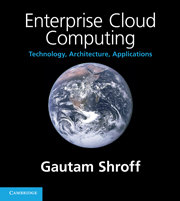Book contents
- Frontmatter
- Contents
- Preface
- List of abbreviations
- Part I Computing platforms
- Part II Cloud platforms
- Part III Cloud technologies
- Part IV Cloud development
- Part V Software architecture
- Part VI Enterprise cloud computing
- Chapter 17 Enterprise cloud computing ecosystem
- Chapter 18 Roadmap for enterprise cloud computing
- References
- Index
Chapter 17 - Enterprise cloud computing ecosystem
Published online by Cambridge University Press: 06 December 2010
- Frontmatter
- Contents
- Preface
- List of abbreviations
- Part I Computing platforms
- Part II Cloud platforms
- Part III Cloud technologies
- Part IV Cloud development
- Part V Software architecture
- Part VI Enterprise cloud computing
- Chapter 17 Enterprise cloud computing ecosystem
- Chapter 18 Roadmap for enterprise cloud computing
- References
- Index
Summary
So far we have covered a number of cloud computing technologies as well as explored their impact on the software needs of enterprises. In the process we have limited our discussion to the major cloud computing providers, viz. Amazon, Google and Microsoft, with most of our examples taken from the first two, given that Microsoft's offering is still in its nascent stages at the time of writing.
However, the cloud computing ecosystem includes other cloud providers, albeit smaller than the three major ones. Additionally, there are a range of emerging technologies that complement public clouds, enable interoperability between private data centers and public clouds, or facilitate the creation of private clouds within enterprises.
Figure 17.1 depicts our classification of the cloud ecosystem from an enterprise perspective, also indicating the organizations involved in creating and bringing these technologies to market. Needless to say this list of organizations is incomplete and evolving; moreover, given the rate of innovation in the cloud space, it is possible that additional technology categories may emerge in the future. (Note: there are other similar classifications, such as the OpenCrowd taxonomy, which includes a far broader range of technologies and applications.)
The enterprise cloud ecosystem comprises of three main categories; cloud service providers, tools for using and managing cloud deployments and tools for building private clouds.
Information
- Type
- Chapter
- Information
- Enterprise Cloud ComputingTechnology, Architecture, Applications, pp. 243 - 252Publisher: Cambridge University PressPrint publication year: 2010
